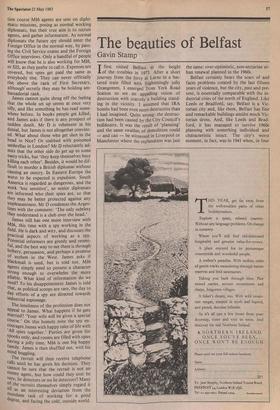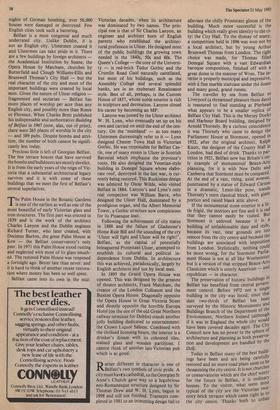The beauties of Belfast
Gavin Stamp
T first visited Belfast, at the height 1 of the troubles in 1973. After a short journey from the ferry at Larne in a bat- tered train filled with frighteningly jolly Orangemen, I emerged from York Road Station to see an appalling vision of destruction with scarcely a building stand- ing in the vicinity. I assumed that IRA bombs had been even more destructive than I had imagined: Quite wrong: the destruc- tion had been caused by the City Council's bulldozers. It was the result of 'planning' and the same swathes of demolition could — and can — be witnessed in Liverpool or Manchester where the explanation was just
the same: over-optimistic, non-sectarian ur- ban renewal planned in the 1960s.
Belfast certainly bears the scars of and faces problems created by the last fifteen years of violence, but the city, past and pre- sent, is essentially comparable with the in- dustrial cities of the north of England. Like Leeds or Bradford, say, Belfast is a Vic- torian city and, like them, Belfast has fine and remarkable buildings amidst much Vic- torian dross. And, like Leeds and Brad- ford, it has managed to survive 1960s planning with something individual and characteristic intact. The city's worst moment, in fact, was in 1941 when, in four nights of German bombing, over 56,000 houses were damaged or destroyed. Few English cities took such a battering.
Belfast is a most congenial and much underrated city. ,Unlike Dublin, it is not an English city. Ulstermen created it and Ulstermen can take pride in it. There are a few buildings by foreign architects the Academical Institution by Soane, the Opera House by Matcham, churches by Butterfield and Clough Williams-Ellis and Brumwell Thomas's City Hall — but the real character of the city and most of the important buildings were created by local men. Given the nature of Ulster religion fragmented and sectarian — Belfast has more places of worship per acre than any English city, and possibly more than Rome or Florence. When Charles Brett published his indispensable and authoritative Building. of Belfast in 1967 (now, alas, out of print), there were 265 places of worship in the city — and 589 pubs. Despite bombs and attri- tion, the number of both cannot be signifi- cantly less today.
Precious little is left of Georgian Belfast. The few terrace houses that have survived the bombs and bulldozers are mostly derelict. It is from the early years of the reign of Vic- toria that a substantial architectural legacy survives and it is with some of these buildings that we meet the first of Belfast's several superlatives.
The Palm House in the Botanic Gardens is one of the earliest as well as one of the most beautiful of early Victorian glass and iron structures. The first part was erected in 1839 and is the work of the architect Charles Lanyon and the Dublin engineer Richard Turner, who later created, with Decimus Burton, the great Palm House at Kew — the Belfast conservatory's only peer. In 1971 this Palm House stood rusting and neglected with most of its glass smash- ed. The restored Palm House was reopened a fortnight ago. Better late than never: and it is hard to think of another recent restora- tion where money has been so well spent.
Belfast came into its own in the mid-
Victorian decades, when its architecture was dominated by two names. The prin- cipal one is that of Sir Charles Lanyon, an engineer and architect born of English parents who established the architec- tural profession in Ulster. He designed most of the public buildings the growing town needed in the 1840s, 50s and 60s. The Queen's College — the core of the Universi- ty — is red-brick Tudor Gothic and the Crumlin Road Gaol naturally castellated, but most of his buildings, such as the Assembly College and several splendid banks, are in an exuberant Renaissance style. Best of all, perhaps, is the Custom House of 1857, whose noble exterior is rich in sculpture and decoration. Lanyon closed his career by becoming an MP.
Lanyon was joined by the Ulster architect W. H. Lynn, who eventually set up on his own and carried on until the end of the cen- tury. On the 'mainland' — as too many Ulstermen distressingly refer to it — Lynn designed Chester Town Hall in Victorian Gothic. He was responsible for Belfast Cas- ' tie, one of many essays in Ulster in Scottish Baronial which emphasise the province's roots. He also designed the Venetian-style building in Donegal Square whose elabo- rate roof, destroyed in the last war, is cur- rently being restored. This Ruskinian design was admired by Oscar Wilde, who visited Belfast in 1884. Lanyon's and Lynn's only real competitor was William Barre, who designed the Ulster Hall, dominated by a prodigious organ, and the Albert Memorial Tower, a Gothic structure now conspicuous for its Pisaesque lean.
Following the achievement of city status in 1888 and the failure of Gladstone's Home Rule Bill and the sounding of the cry 'Ulster will fight and Ulster will be right!', Belfast, as the capital of potentially beleaguered Protestant Ulster, attempted to establish its cultural and political in- dependence from Dublin. In architecture this was achieved, paradoxically, largely by English architects and not by local men.
In 1895 the Grand Opera House was opened. This was designed by the greatest of theatre architects, Frank Matcham, the creator of the London Coliseum and the Buxton Opera House. Diagonally opposite the Opera House in Great Victoria Street and directly opposite the horrible Europa Hotel (on the site of the old Great Northern railway terminus for Dublin) stands another jolly building dedicated to entertainment: the Crown Liquor Saloon. Combined with the civilised licensing hours, the interior is a drinker's dream with its coloured tiles, stained glass and - wooden partitions. I cannot think of another late Victorian pub which is as good.
Rather different in character is one of Belfast's two symbols of civic pride. A city must have a cathedral, so the Georgian St Anne's Church gave way to a lugubrious neo-Romanesque structure designed by Sir Thomas Drew and W. H. Lynn, begun in 1898 and still not finished. Transepts com- pleted in 1981 to an interesting design fail to alleviate the chilly Protestant gloom of the building. Much more successful is the building which really gives identity to the ci- ty: the City Hall. To the dismay of many, a competition held in 1896 was won not by a local architect, but by young Arthur Brumwell Thomas from London. The right choice was made, for Thomas filled Donegal Square with a vast Edwardian baroque composition, finished off with a great dome in the manner of Wren. The in- terior is properly municipal and impressive, with a fine marble staircase under the dome and many good, grand rooms. The traveller by sea from Belfast to Liverpool (a threatened pleasure these days) is reassured to find standing at Pierhead what appears to be a smaller replica of Belfast City Hall. This is the Mersey Docks and Harbour Board building, designed by Arnold Thornely. By a curious coincidence it was Thornely who came to design the Parliament House at Stormont, opened in 1932, after the original architect, Ralph Knott, the designer of the County Hall in London, had died of drink. Thanks to par- tition in 1921, Belfast now has Britain's on- ly example of monumental Beaux-Arts planning, for it is with New Delhi and Canberra that Stormont must be compared. At the end of a vast, rising, axial avenue, punctuated by a statue of Edward Carson in a dramatic, Lenin-like pose,
stands Thornely's stern classical block, with giant portico and raised blank attic above.
If the monumental stone exterior is a lit- tle frigid, the interiors are fine and it is sad that they cannot easily be visited. But Stormont is unloved because it is a building of unfashionable date and style, because its vast, neat grounds are t°13 remote from the city centre and because the buildings are associated with imposition, from London. Stylistically, nothing could be more wrong, for the Stormont Parlia- ment House is not at all like Westminster but is a version of that stripped Beaux-Arts Classicism which is utterly American — and republican — in character. The preservation of historic buildings in Belfast has benefited from central govern- ment control. Before 1972 not a single building in the city was listed; since that date two-thirds of Belfast has been, surveyed by the Historic Monuments and Buildings Branch of the Department of the Environment, Northern Ireland (although if it was in England the whole city would have been covered decades ago). The city Council now has no power in the sphere of architecture and planning as both preserva- tion and development are handled by the DoE. Today in Belfast many of the best build- ings have been and are being carefully restored and no more road plans seem to be threatening the city centre. It is not churches or conservatories which are the chief worry for the future in Belfast, it is ordinary houses. To the visitor, what seem most typical of the city are the Victorian two- story brick terraces which came right in to the city centre. Thanks both to urban
renewal plans and sectarian violence, far too many of these have been bulldozed or stand forlorn, with their windows and doors bricked up. Their inhabitants have been obliged to move further out, to dreary post-war, Harlow-style housing estates where, today, most of the violence takes place. In England, the old terrace houses would be bought and restored by young middle-class professionals; it is Belfast's peculiar tragedy that 'gentrification' has been inhibited by the threat of IRA bombs.












































 Previous page
Previous page